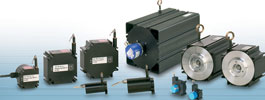

Micro-Epsilon offers an extensive range of draw-wire displacement sensors, with ranges extending from 50 mm to 50 m. A distinguishing characteristic is their compact size; for example, a sensor with a measurement range of 750 mm has a housing measuring just 30 mm. The measured displacement can be output as an analog current, voltage or potentiometric signal. For a digital output, there is a choice of HTL or TTL and there are interfaces for the popular fieldbus systems, such as CANopen, SSI and Profibus.
The basic idea behind a draw-wire displacement sensor is very similar to that of a classical tape measure. Whereas a bricklayer on a building site must read the length of the extended measuring tape from the markings, draw-wire sensors take measurements automatically by counting the rotations of the drum on which the steel wire is wound. The drum has a long-life spring drive, which ensures that the steel wire is re-wound. A linear motion is therefore translated into a rotary motion which can be gauged via either one of three different measurement methods available: a multiturn potentiometer, an incremental encoder or an absolute encoder. These are mounted on the drum axle and in this way convert the drum rotation into a signal which can be evaluated. As with a tape measure, draw-wire sensors can measure around corners and edges. Deflection pulleys are needed for this, which deflect the wire in the desired direction.
Thanks to the use of precision components for the manufacture of the devices, Micro-Epsilon’s sensors are characterised by an extended average service life. For particularly harsh environments, versions with up to IP67 protection are available, while on more simple models, the housing is made of plastic. If higher demands are made on the ruggedness, aluminium profile housings are available. The product range is rounded off by a comprehensive range of accessories, including brackets, wire extensions, deflection pulleys and various magnetic holders for the sensor and wire.
The draw-wire mechanisms are also available separately with an adapter for the customer’s own encoder. In this way, customers who possess the appropriate encoder technology, but do not manufacture their own draw-wire sensors, can offer their customers a suitable complete solution.
The possible applications for draw-wire displacement sensors are varied and extend from lift and crane constructions (to prevent the crane from toppling over), to applications in the medical and space technology. Probably the most spectacular application example is related to the Ariane rocket launcher. Once a satellite has reached a safe distance from the space craft during deployment, the wire sensor is responsible for supplying the triggering signal for starting the satellite’s own drive.
Other fields of application, albeit less spectacular, can be found in the lift measurement of industrial trucks and conveyors, or in the incline and tilting of patient couches in the medical environment. Draw-wire sensors are used anywhere where distances and tilts need to be measured by contact.
For more information contact Dieter Netter, Associated Technology, +27 (0)11 802 3320, [email protected], www.associated-technology.co.za
| Tel: | +27 11 802 7020 |
| Email: | [email protected] |
| www: | |
| Articles: | More information and articles about Associated Technology |

© Technews Publishing (Pty) Ltd | All Rights Reserved